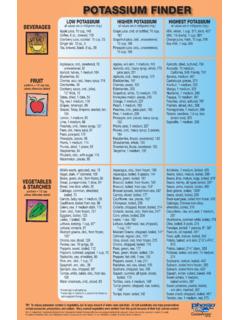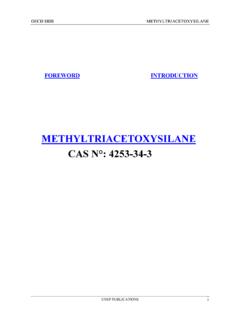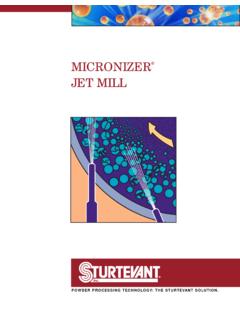Transcription of The Connecticut Station, Control of Potamogeton …
1 The Connecticut Agricultural Experiment Station, New Haven, CT Control of Potamogeton crispus and myriophyllum spicatum in Crystal Lake, Middletown, CT. 2006 - 2008. Bulletin Gregory J. Bugbee January 2009. Prepared for the Connecticut Department of Environmental Protection Pursuant to aquatic vegetation Control permit # 07147. Table of Contents 1. Introduction .. 3. 2. Objectives 4. 3. Materials and Methods . 5. Visual surveys .. 5. Transects .. 5. Georeferenced grid .. 7. Water chemistry .. 7. Installation and removal of limnobarriers .. 8. Application of herbicide .. 8. 6. Results and Discussion .. 8. Visual Survey .. 8. Transects .. 8. Georeferenced grid .. 9. Presence of Protected Plant Species .. 14. Water Chemistry . 14. 8. Conclusions .. 16.
2 9. Acknowledgements .. 16. 10. References .. 17. 11. Appendix.. 18. Chain of custody water chemistry 19. Herbicide Permit .21. 2. Control of Potamogeton crispus and myriophyllum spicatum in Crystal Lake, Middletown, CT 2006-2008. Figure 1. Potamogeton crispus reaching surface in Crystal Lake. Introduction: Crystal Lake is a 32-acre state owned water body located in Middletown, CT. It has a mean depth of 3 meters and a maximum dept of 9 meters (Jacobs and O'Donnell, 2002). The southern half of the lake is shallow with a muck bottom, while the northern half is deep with a bottom consisting of considerable ledge and rock. Public access via a state boat launch ramp and a town beach is available at the southern end. At the northern end, a private club operates a second beach.
3 The remainder of the shoreline consists of private residences with the exception of an undeveloped peninsula jutting out from the southwest corner. Recreational use of the lake has become increasingly hindered by the invasive aquatic plant Potamogeton crispus (curly leaf pondweed) (Figure 1). Invasive aquatic plant species can threaten native species (Pimentel et al. 2000) and reduce property values of homes nearby (Fishman et al. 1998). Potamogeton crispus is now found in all New England states (IPANE, 2009). It is most problematic in the months of May and June then it sets reproductive structures, called turions, and rapidly disappears (Capers et al. 2005). myriophyllum spicatum (Eurasian water milfoil) is another invasive species that inhabits the lake, but to date has reached only moderate nuisance levels.
4 An aquatic plant listed by the State of Connecticut as an endangered species, called Potamogeton vaseyi (Vasey's pondweed), has been determined by the Connecticut Department of Environmental Protection (CT DEP). to also inhabit Crystal Lake. In 2006, the CT DEP located two patches of Potamogeton vaseyi near the west end of the town beach and the west side of the southern island (Figure 2). Samples of these plants reside in the George Safford Torrey Herbarium (CONN) at the 3. Control of Potamogeton crispus and myriophyllum spicatum in Crystal Lake, Middletown, CT 2006-2008. Figure 2. Locations of Potamogeton vaseyi (left) and limnobarriers (right) in Crystal Lake. University of Connecticut in Storrs. In cooperation with the Town of Middletown and residents concerned about the condition of Crystal Lake, The Connecticut Agricultural Experiment Station (CAES) was asked to devise a strategy to Control the nuisance vegetation with an herbicide.
5 CAES decided to test an April application of the herbicide Reward (diquat dibromide). Reward is a contact herbicide that has short residual activity in the environment. The April treatment was earlier than typi- cally performed but holds promise to Control the Potamogeton crispus before it produces the turions needed to produce the following year's plants (Getsinger, 2005). In addition, native plants like Potamogeton vaseyi, begin growth later in the season and, therefore, may be of- fered some protection. Further protection of P. vaseyi from herbicides could be offered by installing an impermeable barrier from surface to bottom around the plant patches. Com- mercial products called, called limnobarriers, are available for this purpose and will be tested as part of this study.
6 Objectives: 1. Determine the effectiveness of controlling Potamogeton crispus and myriophyllum spicatum with an early season application of Reward. 2. Determine the effectiveness of the early season application on preserving Potamogeton vaseyi and other native vegetation. 3. Determine if limnobarriers are necessary to prevent the herbicide from harming Potamogeton vaseyi. 4. Control of Potamogeton crispus and myriophyllum spicatum in Crystal Lake, Middletown, CT 2006-2008. Figure 3. Installation of limnobarrier around island in Crystal Lake. Materials and Methods: Visual Surveys We conducted midsummer visual surveys before the herbicide application in 2004 and after the herbicide application in 2007 and 2008. The 2004 survey was part of a CAES statewide monitoring effort (CAES IAPP, 2009).
7 We used survey and transect protocol as established by the CAES Invasive Aquatic Plant Program (IAPP) (CAES IAPP, 2009) and a more thorough georeferenced grid technique described below. Our visual survey was accomplished by slowly traveling through the littoral zone and recording all aquatic plant species on a bathymetric lake map. To identify plants that were not clearly visible, we obtained samples from water less than three meters deep by hand or with a long-handled rake. In deeper water, we obtained plants with a grapple attached to a rope. When field identification was questionable, we brought samples back to the lab for further review using the taxonomy of Crow and Hellquist (2000a, 2000b). Depth was measured by rake handle, drop line or digital depth finder.
8 Particular attention was paid to areas where the CT DEP. had found Potamogeton vaseyi and these locations were protected with limnobarriers. Because Potamogeton vaseyi is rare, it is not easy to identify. Nancy Murray, a CT DEP. wildlife biologist who specializes in rare and endangered species, checked the lake for the presence of Potamogeton vaseyi each year to supplement this study. Transects We used the CAES IAPP (2007) transect method to collected quantitative frequency and abundance information on the aquatic plants in 2007 and 2008 and compared the results to data gathered from the same transects in 2004. We selected transect locations using a ran- dom-representative method to assure that all variety of habitat types were represented. We established four transects positioned perpendicular to the shoreline.
9 We recorded the fre- quency and abundance of each plant species found within a 2 m area at 0, 5, 10, 20, 30, 40, 50, 60, 70 and 80 m from the shore. Transects 1, 2 and 3 contain 10 points while tran- sect 4 contains only 6 points because of the narrowness of the lake. We took transect data in the late summer of each year. Species abundance was ranked on a 1 5 scale (1 = rare - 5 = very abundant). One specimen of each species was mounted and placed in the CAES herbarium (NHES). 5. Control of Potamogeton crispus and myriophyllum spicatum in Crystal Lake, Middletown, CT 2006-2008. Figure 4. Visual surveys aquatic plant vegetation surveys of Crystal Lake 2004, 2007, 2008. Table 1. Presence (Y) or absence (N) of turions on Potamogeton crispus prior to treatment.
10 Site 1 Site 2 Site 3 Site 4. Rep Length* Turions Length* Turions Length* Turions Length* Turions # (cm) old new rhizome (cm) old new rhizome (cm) old new rhizome (cm) old new rhizome 1 60 N N Y 40 Y N Y 35 Y N Y 70 Y N Y. 2 55 N N Y 80 N N Y 30 Y N Y 68 Y N Y. 3 50 N N Y 50 N N Y 25 N N N 25 Y N Y. 4 45 N N Y 30 N N Y 15 N N N 70 N N Y. 5 40 N N Y 45 N N N 30 N N Y 70 N N Y. 6 40 N N Y 30 N N Y 28 N N Y 50 N N Y. 7 65 N N Y 33 N N Y 28 N N Y 85 Y N Y. 8 50 N N Y 40 N N Y 15 N N Y 40 Y N Y. 9 65 N N Y 50 Y N Y 16 Y N Y 95 Y N Y. * Stem length Georeferenced grid A georeferenced grid method for quantifying plant frequency and abundance was utilized in 2006, 2007 and 2008. We took vegetation samples with a grapple at one-second longitudinal and latitudinal intervals throughout the entire lake in both spring and summer (Figure 5, 6, 7).













